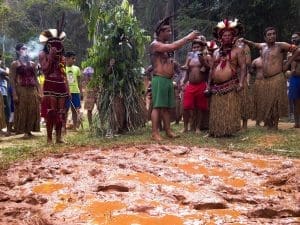
To begin with, Indigenous communities around the world have always shared a deep and respectful relationship with nature. In fact, their fishing traditions are not only practical methods for finding food but also meaningful spiritual experiences. Because of this, understanding Rituals and Ceremonies in Indigenous Fishing helps us appreciate the wisdom behind these ancient practices. Moreover, these traditions reveal how people can live in balance with rivers, lakes, and oceans.
Contents
The Spiritual Connection with Water🐟
First of all, water is not just a natural resource for Indigenous peoples. Instead, it is a living being that deserves respect, love, and gratitude. Therefore, many fishing practices start with ceremonies that honor the spirit of the water.
Water as a Sacred Being
For many communities, water represents life, healing, and guidance. As a result, fishing becomes more than catching fish; it becomes a moment of connection. Children learn early on that water is their friend, and this simple idea shapes their entire relationship with nature. Furthermore, water is often described as a mother who feeds and protects.
Animals as Spiritual Guides
Interestingly, many Indigenous stories explain that certain animals taught humans how to fish. For example, some coastal cultures believe dolphins once guided elders to rich fishing grounds. Because of this, ceremonies often thank not only the water but also the animals that share their wisdom. In addition, these stories help young listeners imagine a world where every animal has something to teach.
Rituals Before Fishing🐟
After understanding the spiritual connection, it becomes clearer why rituals before fishing matter so much. Besides, these acts help fishermen prepare their minds and bodies for a respectful interaction with nature. If you enjoy ocean mysteries, don’t miss our thrilling collection of Supernatural Ship Stories: Ghosts, Legends, and Mysteries at Sea.
Cleansing the Body and Mind
Before touching their tools, many fishers perform small purifying rituals such as:
- Washing their hands in flowing water
- Singing or whispering short prayers
- Burning aromatic plants like cedar or sage
Through these steps, fishers calm their minds and focus on gratitude. Additionally, children are often invited to join, making the moment peaceful and full of learning.
Simple Offerings
In several cultures, a small offering is placed into the water before the first cast. Usually, this offering may include flowers, seeds, or a few drops of a traditional drink. In turn, the offering thanks the water for the fish that will soon nourish the community. Moreover, this action reminds everyone that nature gives freely, but only if humans approach with respect.
Ceremonies During the Fishing Process🐟
Once the fishing begins, ceremonies continue. Even so, they never interrupt the work. Instead, they blend seamlessly into the rhythm of the activity.
Guiding Songs
Some communities use songs to guide their movements. Consequently, these melodies set a calm pace that helps the group work together. The songs may be simple, but they carry stories and lessons from elders. In addition, singing keeps spirits high even when fishing becomes challenging.
Ritual Movements
Certain fishing gestures also have ceremonial meaning. For instance, the way a net is thrown may resemble a dance that honors water spirits. Moreover, these movements teach rhythm, patience, and careful coordination. Thus, tradition and technique become one fluid practice.
Post-Fishing Ceremonies🐟
After the fishing ends, ceremonies continue to show gratitude. Because of this, the end of the process is just as meaningful as the beginning.
Giving Thanks for the Catch
Fishers typically gather to thank the water and the fish for the food provided. Whether the catch is big or small, gratitude is essential. Furthermore, this moment reminds the community that taking only what is needed protects future generations.
Sharing the Harvest
In many Indigenous cultures, the fish are shared fairly. This often includes:
- Elders
- Families with fewer resources
- Community members unable to fish
By doing this, everyone benefits. Additionally, sharing reinforces unity and kindness within the group.

Sacred Tools and Their Symbolism🐟
Next, it is important to understand that many fishing tools are not just objects. Rather, they carry spiritual significance and cultural memory.
Ceremonial Nets
Some nets are created exclusively for special occasions. These nets may include:
- Meaningful knots
- Herbal dyes
- Small symbolic charms woven into the threads
As a result, the tools become more than equipment—they become storytellers. Additionally, crafting these nets strengthens community bonds. To understand how fragile marine life truly is, explore our guide on Coastal ecosystems and their fragility.
Traditional Rods and Spears
Rods and spears are often made from sacred wood. Before cutting the tree, people ask permission from its spirit. Thus, the process itself is another ceremony. Moreover, this respectful approach teaches children that every material comes from a living world that deserves gratitude.
Passing Knowledge Through Generations🐟
At this point, it is clear that rituals play a vital role in Indigenous fishing. However, these traditions would not survive without intentional teaching.
Learning by Watching
Children learn by observing adults during fishing trips. In doing so, they absorb language, rhythm, and values. Furthermore, they learn patience and respect—two qualities essential for both fishing and life.
Stories That Teach
Elders often tell stories around the fire or while repairing nets. These tales may feature river guardians, talking fish, or magical animals. Not only do these stories entertain, but they also teach lessons about kindness, courage, and balance.
Cultural and Environmental Impact🐟
Finally, the value of these rituals extends far beyond tradition.
Protecting Nature
Indigenous fishing practices emphasize respect and moderation. Therefore, communities rarely overfish. As a result, fish populations remain healthy, and ecosystems stay balanced. Additionally, these practices serve as powerful examples of sustainable living.
Preserving Identity
Rituals protect cultural identity. Because of this, they help communities stay connected to their ancestors. Furthermore, they remind each new generation that they belong to a long, meaningful story.
Final Reflection🐟
In summary, Rituals and Ceremonies in Indigenous Fishing represent a beautiful blend of culture, spirituality, and environmental wisdom. Moreover, these traditions teach us that fishing is not just a physical act, but a moment of gratitude, unity, and respect. Above all, they show that when humans care for nature, nature cares for them in return.

